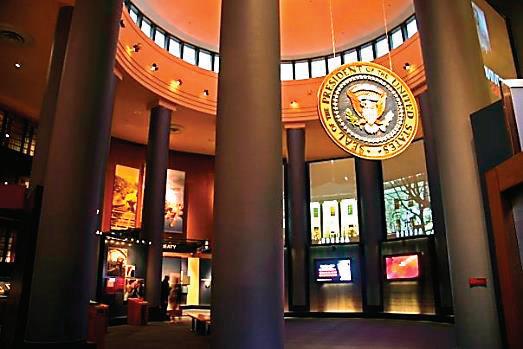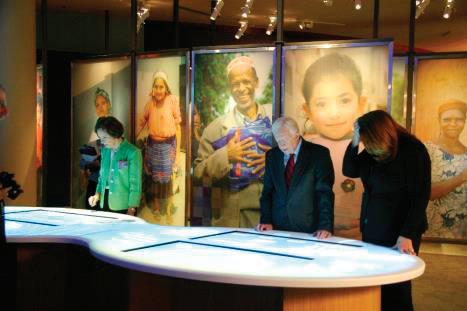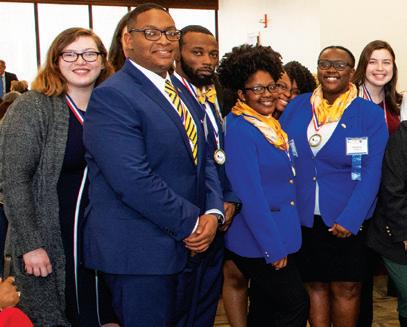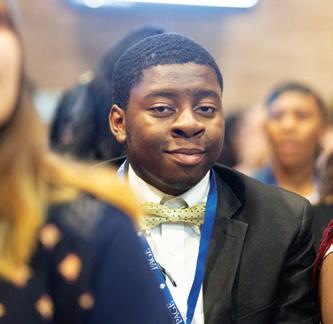
12 minute read
Carlos Hernandez
Carlos Hernandez General Ray Davis Middle School, Rockdale County
By Meg Thornton, PAGE One Editor
Rockdale County veteran teacher Carlos Hernandez does not fear a world in decline. Quite the opposite. His knowledgeable, techno-savvy and caring eighth-grade social students and their generation at large have imbued him with a strong faith.
“I have great hope that they will rise up and answer many of the questions that have been unsolvable,” said the General Ray Davis Middle School teacher. “I see a future, a generation that is going to take care of me, and I am not scared. … After my years of teaching are up and I am enjoying retirement, I believe my quality of life will be improved by the innovations in healthcare and overall lifestyle that this generation will [develop].”
Hernandez sees his role as fostering that potential. As such, he deftly uses technology to break lessons into menu-like offerings to engage students and accommodate varied learning styles and abilities. Students showcase their talent and abilities through journaling, storyboards, poetry, songs, interpretive dance and more.
“[They have] tools at their disposal to create things that former generations could only imagine,” said Hernandez. “And they have the ability to multitask in ways that leave me jealous. … The potential that lives within them is ready to be tapped into and explored.”
Hernandez encourages fellow educators to think about the possibilities afforded by advancements in this changing world and “adjust our teaching to reach this new generation of thinkers.”
His social studies students are already action-oriented. In studying current events, they often discuss what they can do to help. After Hurricane Matthew barreled through Haiti, for example, his students mobilized to assist a national Food for the Poor initiative.
“My first-period class very quickly started to organize within the classroom, and we hatched out a plan,” relayed Hernandez. “Before we knew it, we had our school videography class involved in filming a commercial, we had students creating posters and signs, we had students making donation containers for each homeroom, and classes all over the school joined in creative ways to raise money for this effort. Over the next several weeks we raised three times the amount that we set as a goal.”
Hernandez believes such activities connect students with the larger world. “Our students are able to think outside of themselves … and make a great change as far away as Haiti and beyond.” Such experiences prompt students to recognize needs in their own community as well. Hernandez said he has
been “honored to stand side by side with many of these students cooking and preparing meals for other students in our county and homeless shelters.” His overarching viewpoint is that “Our students are amazing and simply need the opportunities to show it.”
Hernandez also knows that the road to success for many students is filled with obstacles. Thus he relishes his role as his school’s Positive Behavioral Intervention and Supports (PBIS) coach. His main objective is to help colleagues see behaviors differently.
“This initiative is challenging because there has to be a collaboration with all teachers, staff, administration, students and families … but I am happy to say that it is happening at our school,” he said.
After a year of planning, his school went live with its PBIS initiative, and the “day was amazing,” he reported. Teachers were dancing and playing games with students, and students were having a blast. After the program, teacher comments included: “I have never had so much fun at school,” and “My face hurts from … laughing.” More importantly, General Ray Davis educators report that the program is working. Straight away Hernandez saw students “who would customarily be in trouble for their actions get an opportunity to learn to do better, instead of getting punished immediately. I have heard other students correct and encourage their classmates with our behavior goals, S.O.A.R. (Self Control, On-Task Behavior, Appropriate Attitude and Responsible Actions),” he added.
Hernandez has a personal connection to helping students overcome poor behavior. “I wasn’t always the best student, but I had teachers who saw beyond my mistakes to believe in the potential that was within me. And I see the same things in my students,” he said. Fighting the Affluence Disparity Breaking the cycle of poverty through education is also central to Hernandez. In his 20-plus years of teaching in three different states, he has witnessed time and again the disparity between affluent and poor communities. Hernandez deftly uses technology to break lessons into menulike offerings to engage students and accommodate varied learning styles and abilities. Students showcase their talent and abilities through journaling, storyboards, poetry, songs, interpretive dance and more. 2 0 2 0 G E O R G I A T E A C H E R O F T H E Y E A
R F I N A L I S T
“I was a first-grade teacher in a high poverty area for four years where most of my first graders had not mastered most of their sight words nor phonics skills. I moved to another state and a more affluent area where I taught kindergarten for two years. Most of my students came to kindergarten with many of the skills that I was teaching in the first grade at my other school,” he noted.
A child of poverty himself, Hernandez knows the struggle that lies before these children. In describing his work environment, Hernandez said: “I currently work in one of the largest trailer parks in the state where very few adults have graduated much less been to college. The dreams and aspirations of many of the students do not go beyond the trailer park.”
He added that “Success for many is simply to help the family in some way to get the basics in life: food, clothing and shelter. … I also understand that there is a way out of the cycle of poverty through education. Key people in my life’s journey helped me strive for better things in life. I have found success in being the first in my family to go to college. “Education can help stop the cycle of poverty.”
In response to being named a Georgia Teacher of the Year finalist, Hernandez thanked his fellow educators. “The look on most people’s faces when we tell them what we do, is like ‘oh, no’ this would be their worst nightmare; for us, we love it.”
And he thanked his students: “For our students, we have the ability to speak life into them. We can tear kids down or lift them up. Sometimes, I’ve had bad days, and you know who lifted me up? My eighth-grade students.”
Hernandez, who is fluent in Spanish, grew up in Wilmington, Delaware, and near Panama City, Florida. He earned a bachelor of science in education degree from the University of West Alabama and a master’s in biblical counseling and a master’s of divinity specializing in apologetics from Luther Rice University and Seminary. In addition to chairing his school’s social studies department, he serves on his school’s teacher leadership team and on the Superintendent’s Teacher Advisory Council. n
Kiana Willis Palmetto Elementary School, Fulton County Schools
By Meg Thornton, PAGE One Editor
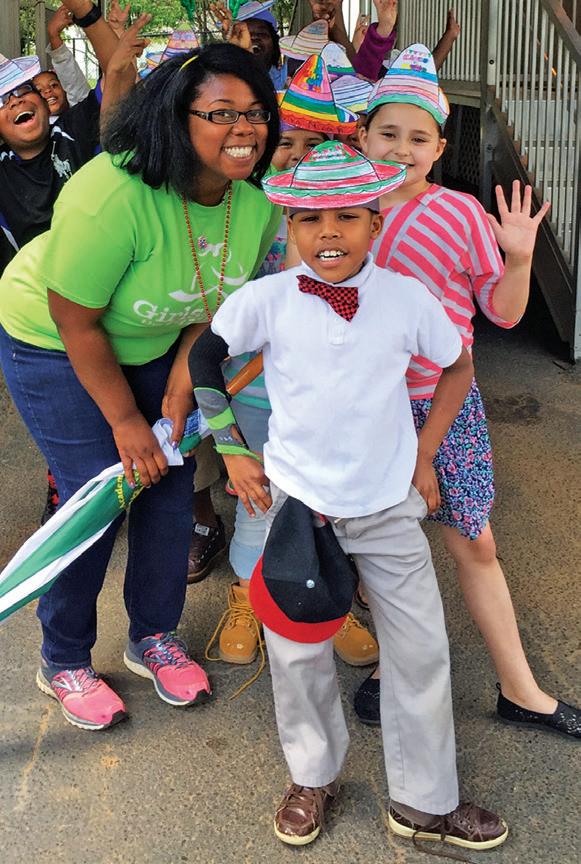
Kiana Willis, a pre-K through fifth-grade teacher at Palmetto Elementary in Fulton County, aims to bridge the gap between content, application and activism. Her S.T.E.A.M classes encourage students to use their knowledge to create change in their communities, and her lessons allow students to grapple with difficult concepts. The goal is to encourage students to ask “Why?”
One lesson that brought all of her goals into play involved access to clean water. The Georgia unit of study for fifth grade asked that students be able to identify microorganisms and whether or not they are harmful. When a student brought in an article on contaminated water, Willis began to build lessons around water as a human right. The class generated the following questions: Who has access to clean water? Why are there people who do not have access? Should we consider access to clean water as a basic human right?”
The class researched, watched TedTalks and engaged in critical discourse.
“As the unit progressed, we discussed the idea of water poverty in the United States and the disparity in resources based on race, class, gender and socioeconomic status,” said Willis. “Students were amazed that there were people living only minutes from them who did not have clean water,” she added.
That led to an understanding of the Flint, Michigan, water crisis. “I expressed to my students that it is not enough for us to be outraged and upset. As scientists, engineers, technology specialists, mathematicians and artists, it is important for us to act and use our collective knowledge and acumen to create change,” she added.
The students then progressed to the next logical step: exploring solutions. After studying the research of Deepika Kurup, the students decided that the most environmentally friendly and costefficient solution was to create water filters. In small groups, students planned, constructed and tested multiple models of water filters using recyclable and easily accessed materials. Once they found their most efficient model, they created a “Shark Tank” presentation and presented their filter and findings to a school community panel that had to decide whether or not to invest in their product. They created a plan for distribution, public service announcements, posters and more to enhance their presentation. Each student played a vital role in the process. STEAM Week Is a Big Hit Willis believes that when you see a need, you address it. To that end, she is a charter member of the School Governance Council, which sets and moni‘Before, when I asked students to draw me a picture of a scientist, they drew a stereotypical Caucasian man in a white coat with big hair. Now, when we ask students to draw a picture of a scientist, they draw themselves.’
tors the strategic direction of the school. The council sought to increase student proficiency in math and science, but also agreed that there was an element of creativity, individuality and social-emotional learning missing from the curriculum. In response, they chose STEAM as a school-wide initiative, and through a grant, received funding.
Willis’ most influential part of the initiative was STEAM night. To attract parents, she created a committee and collaborated with stakeholders to create a funfilled evening full of experiments, musical performances, prizes, speakers and demonstrations. “With a typically low turnout for all events at the school, we were blown away at the overwhelming response we received from parents, students, teachers and community members,” she recalled. “The turnout was unexpected.”
The successful event is now a weeklong annual celebration. For the past three years, STEAM Week is the most anticipated week for students, teachers and parents. It’s full of engaging lessons, hands-on activities, professionals from the community and more.
“Before, when I asked students to draw me a picture of a scientist, they drew a stereotypical Caucasian man in a white coat with big hair. Now, when we ask students to draw a picture of a scientist, they draw themselves,” said Willis. “The greatest student outcome is offering students the opportunity to see themselves full of potential. With the implementation of STEAM, students are now excited about math and science. They no longer see failure as final. They are actively engaged in the construction of their own knowledge, because they see it as a valuable.”
Willis’ students also experience content through the eyes of those who have been marginalized. Here’s how she described a lesson on The Great Depression: “Instead of (simply) reading out of a book, we are living The Great Depression through the eyes of a nine-year-old girl, Cassie Logan, in the book "Roll of Thunder, Hear My Cry." By constructing engaging, authentic, constructivist lessons, I allow my students to take ownership of their own leaning. This empowers them to use the knowledge and information they have been grappling with in class and apply it to real-world scenarios. The young woman in the book is experiencing racial injustice at the tender age of nine. As we read the book, students are making connections to their experiences with bullying and have been asking and reflecting about what they can do to create a safer and more accepting school community. Authentic learning transforms learners and inspires them to effect change in their communities.”
Willis’ overarching approach to teaching is to build off of student interests. “Whatever they’re interested in that goes along with the curriculum, that’s what we do,” she said.
And as a teacher leader, Willis is a mentor, collaborator, coach and a prolific speaker, including as a guest lecturer for Emory University pre-service educators. A member of the National Science Teachers Association, she is in her 12th year of teaching. “There is nothing else on the face of the planet as cool as being a teacher,” said Willis, who uses humor daily in her classroom. Her favorite quote: “Teach anyway.”
Willis earned her bachelor’s degree in early childhood education from Spelman College, a master’s degree in reading, language and literacy from Georgia State University and a specialist degree in educational leadership from Columbus State University. She has both a gifted and science endorsement and is currently developing a curriculum called ActivistDriven Inquiry. n 2 0 2 0 G E O R G I A T E A C H E R O F T H E Y E A
R F I N A L I S T ‘There is nothing else on the face of the planet as cool as being a teacher,’ said Willis. Her favorite quote: ‘Teach anyway.’
MUSEUM TOURS.
TEACHER RESOURCES. PROFESSIONAL DEVELOPMENT. AGES 16 AND UNDER ALWAYS FREE.
TO MAKE A RESERVATION PLEASE VISIT: WWW.JIMMYCARTERLIBRARY.GOV/EDUCATION 404.865.7100 441 JOHN LEWIS FREEDOM PKWY NE, ATLANTA, GA 30307



